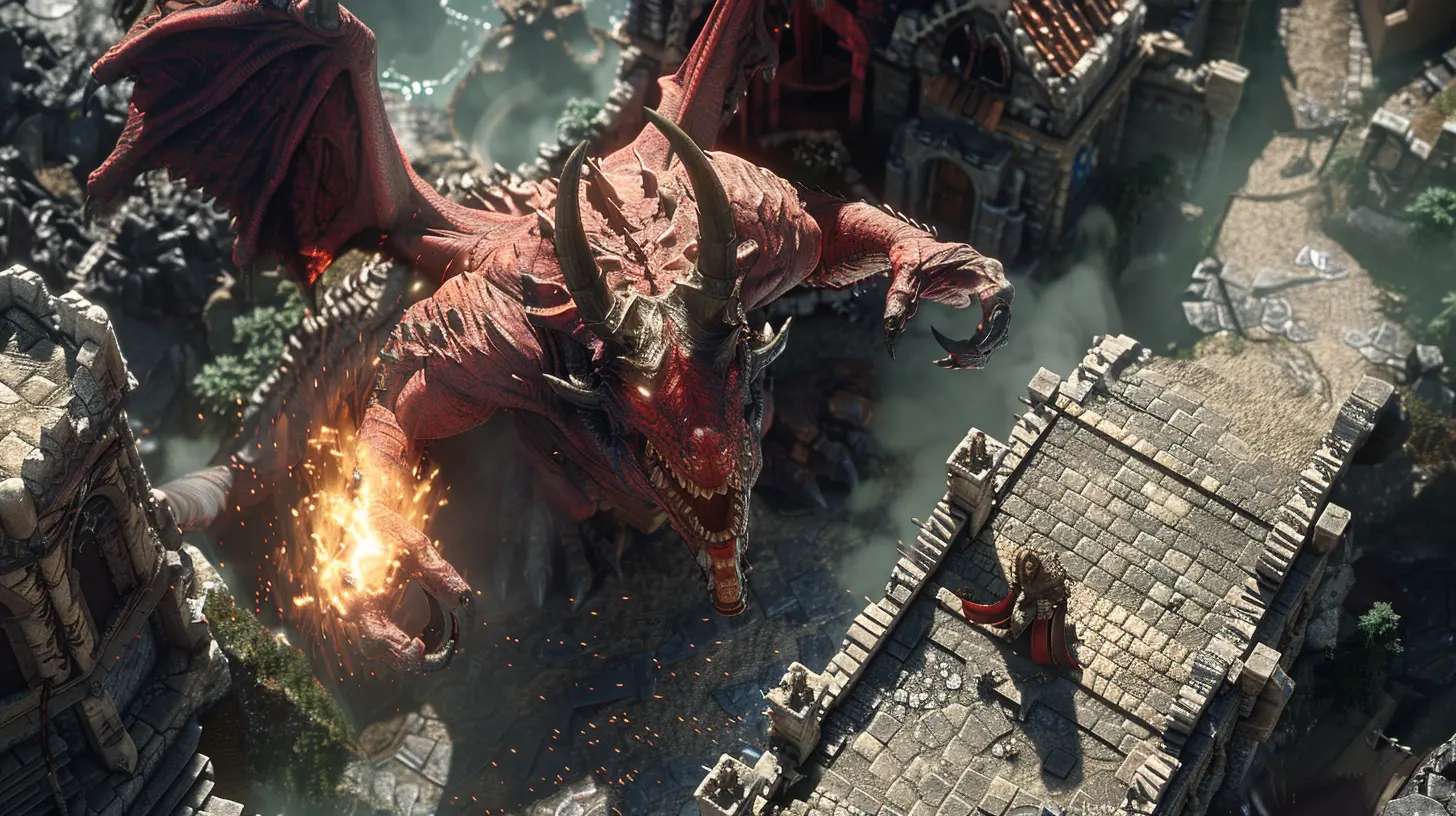18 March 2025
If you've ever played an RPG (Role-Playing Game), you’ve likely faced that heart-racing moment when your meticulously planned strategy went down the drain because your healer drew too much attention or your tank lost control of the battlefield. Sounds familiar? Whether you’re a seasoned adventurer or a newbie to the genre, aggro control is one of those mechanics you’ve got to master to keep things running smoothly. But what exactly is aggro control? And why does it play such a crucial role in RPGs? Let’s break it down.

What Is Aggro, Anyway?
First, let's get on the same page. "Aggro" is shorthand for "aggression," and in the context of games, it refers to how enemies decide who to attack during combat. Think of it as having a virtual "who’s annoying me the most" meter in an enemy’s mind. The higher your aggro, the more likely you are to become their next target.It’s like being in a crowded coffee shop, and someone starts blasting music on their phone while you’re trying to work. Your irritation grows, and you eventually snap—they've drawn your aggro. That’s more or less how it works in RPGs, but with swords, spells, and snarling monsters instead of Starbucks drama.
Aggro management is all about controlling who the enemies focus on. It's a tug-of-war that requires strategy, teamwork, and a good understanding of game mechanics. Mastering it can be the difference between a triumphant victory and a humiliating game-over screen.
Why Aggro Control Matters
Imagine you’re running a dungeon with your squad. You’ve got a tank (the team’s shield who takes the hits), a healer (the lifesaver who patches you up), and some damage dealers (the heavy hitters who dish out pain). Now, if your healer ends up with all the aggro because they’re spamming heals, or your mage draws unwanted attention by unleashing a catastrophic meteor spell, things can spiral out of control fast.Without proper aggro control, battles become chaotic. Your tank gets ignored, your healer gets squished, and your damage dealers barely have time to swing their swords before getting wiped out. It becomes less of a fight and more of a disaster.
Aggro control, then, is like conducting an orchestra. Everyone has their role, and the tank is the drum major ensuring the enemies stay focused on them while the rest of the party does their part. Lose that rhythm, and the entire performance collapses.
The Many Faces of Aggro
Not all RPGs handle aggro the same way. Some games keep it simple, while others dive deep into mathematical formulas straight out of a physics textbook. Generally, though, aggro comes down to three main factors:1. Actions You Take
Anything you do in combat—whether it’s smashing a goblin with your sword, hitting a boss with a fireball, or healing a teammate—generates aggro. Think of it like adding points to your "annoyance score." The more points you rack up, the more likely you are to become a target.For example:
- Damage output: Big hits build big threat. If you're the rogue critting for insane damage, don't be surprised when a dragon suddenly pivots and roasts you alive.
- Healing: Healers naturally attract a ton of aggro because, well, keeping your team alive is a big deal. Enemies don’t like that.
- Buffs or debuffs: Anything that alters the game state, like powering up your allies or weakening your foes, can also draw attention.
2. Proximity
Many games factor in how close you are to an enemy. If you’re standing toe-to-toe with a minotaur while someone else is sniping from the bushes, the minotaur is more likely to come after you. Proximity can sometimes override other factors, especially in melee-heavy games.3. Special Abilities
Some classes or characters come with built-in tools for managing aggro. Tanks, for example, often have abilities specifically designed to generate threat (“taunts”) or keep enemies focused on them. On the flip side, DPS (Damage Per Second) classes may have tools to lower their own threat to avoid stealing the spotlight.
Tools of the Trade: Managing Aggro Like a Pro
So, how do you actually control aggro and keep your team alive? Here are some key tactics:1. The Tank’s Role
Tanks are the backbone of aggro control. Their job is to draw and hold enemy attention, acting as a meat shield for the rest of the party. They achieve this through abilities that generate high threat, often called "taunts." These moves essentially scream, "Hey, look at me!" to every enemy in range.Many tanks have passive skills that boost their threat generation, making them the ideal targets for enemies to focus on. But this balance can shift quickly if the tank isn’t paying attention or if a DPS character gets a little too trigger-happy.
2. DPS Players and Threat Management
If you’re a DPS player, your job is to do as much damage as possible without pulling aggro from the tank. Easier said than done, right? This requires careful timing and sometimes holding back on your strongest abilities until the tank has firmly established control.Some games provide threat-reducing tools like aggro-dump abilities. For example, rogues might have a "vanish" skill to disappear from an enemy’s radar, or rangers might use traps to distract foes.
3. Healers Staying Under the Radar
Healers often walk a fine line between keeping everyone alive and drawing too much attention. One key tactic is to delay casting your big heals until it’s absolutely necessary. Many healers rely on position as well—staying out of the enemy’s immediate range can be lifesaving.Some RPGs also give healers threat-reduction talents or spells, which can help them fly under the radar.
Aggro Control in Action: Real-World RPG Examples
Let’s talk about some specific games that implement aggro control in interesting ways.World of Warcraft (WoW)
WoW is practically the textbook when it comes to understanding aggro mechanics. Tanks have dedicated abilities like "Taunt" and "Shield Slam" that are custom-built to maintain threat, while DPS classes are encouraged to use tools like "Feign Death" or "Threat Dump."The threat meter in WoW is an iconic example of aggro management in action, showing players exactly who is about to pull aggro and giving them time to adjust.
Final Fantasy XIV (FFXIV)
FFXIV adds its own flavor to aggro control with the "enmity" system. Tanks use abilities that increase enmity, while DPS classes can toggle an "offensive stance" to reduce how much threat they generate. The game even color-codes enemy indicators to show who currently has aggro, making it easy to adjust on the fly.Dark Souls Series
While not a traditional RPG, the Dark Souls series has its own form of aggro management. In co-op mode, players often use gestures, positioning, or even item-based mechanics to manipulate enemy attention. It’s less about formulas and more about reading the battlefield—a refreshing change of pace.Common Mistakes in Aggro Management
Even experienced players can mess up aggro control from time to time. Here are a few common pitfalls to avoid:- Going All Out Too Soon: If you unleash your most powerful attacks before the tank has had a chance to establish control, you’re asking for trouble.
- Ignoring Positioning: Standing right next to the boss, even as a healer or ranged DPS, is a surefire way to get yourself targeted.
- Forgetting Threat Dumps: Many players forget to use their aggro-reducing abilities until it’s too late.
- Overhealing: Spamming heals when they’re not needed can cause unnecessary aggro buildup.
Wrapping It Up
Aggro control is more than just a mechanic—it’s an art form that requires teamwork, timing, and a touch of finesse. Whether you’re commanding a tank, raining fire as a DPS, or keeping everyone alive as a healer, understanding the dynamics of aggro can transform chaotic battles into masterfully executed victories.At the end of the day, it’s all about balance. Think of your team as a well-oiled machine, with aggro control as the glue holding everything together. Nail it, and you’ll feel like an unstoppable force. Miss the mark, and…well, you might find yourself wiping over and over again.
So, the next time you dive into a dungeon, keep these tips in mind. Who knows? Learning the science of aggro control might just make you the MVP of your next epic adventure.







Gunner Henderson
Mastering aggro control transforms gameplay! Embrace strategy and teamwork to enhance your RPG experience. Every battle becomes an opportunity for growth and epic victories!
April 5, 2025 at 3:44 PM